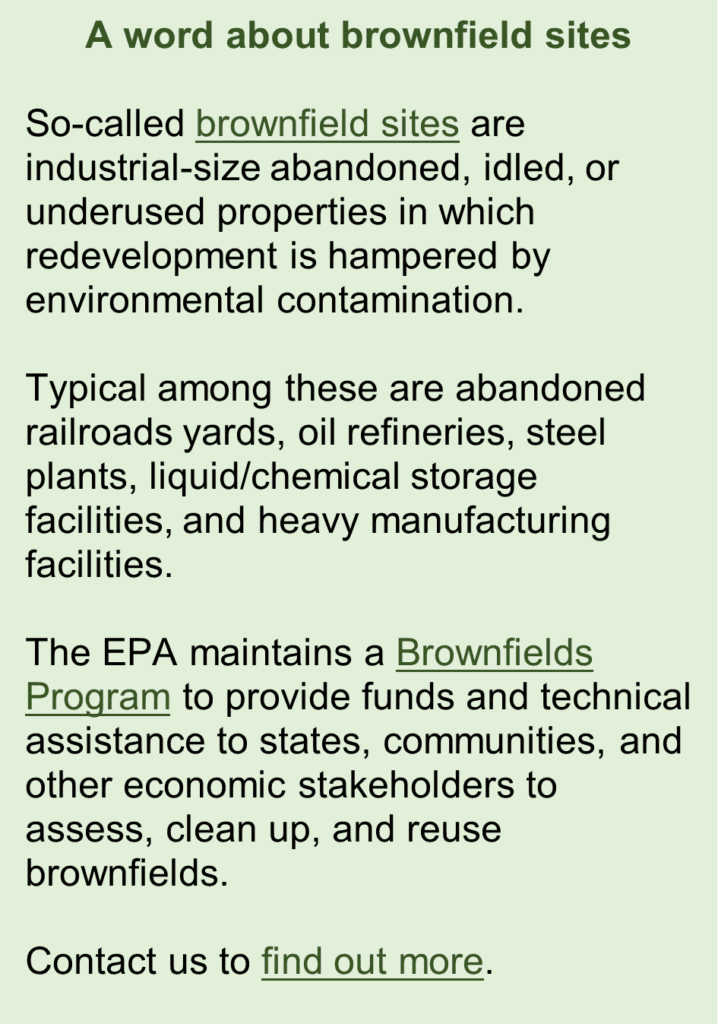A Quick Review of Environmental Remediation (AKA “Site Cleanup”)
August 17, 2021
The official term for “site cleanup” is “environmental remediation” per the EPA. It involves the removal of pollutants or contaminants from what the eco-literati call “environmental media,” and what you probably call “soil,” “sediment,” or “water.”
Why care about environmental remediation?
There are at least three ways environmental remediation can be important to you.
- First, too much of anything can necessitate hazardous waste disposal—no matter how eco-innocent it might seem. For example, even milk can require environmental remediation, if it accidentally gets dumped someplace it ought not to be. Consider:
- While decanting moo juice onto soil might seem harmless at first—after all, we feed the stuff to babies—a slick made of milkfat will block oxygen and sunlight just as effectively as one made of old 5W-30, ecologically devastating nearby waterways.
- Second, there’s the unfortunate case in which you’ve been disposing of something that’s of little interest to the EPA, but then learn that your state has decided that it’s a significant pollutant. California—surprise!—is an example:
- Back in 2007, that state passed a statewide chemistry policy that exceeds the scope of the federal Toxic Substances Control Act (TSCA). And local governments (e.g. San Francisco) also tightened controls. This is not weird at all, as state & local environmental regulations are commonly more onerous than the federal kind.
- Third, there’s the common situation where a known pollutant has been collected somewhere, but now needs to be removed, usually because the site-owner wants to use the property for something else.
- Abandoned gas stations are a prime example, where leaky storage tanks have let gasoline leach into the soil. So are defunct shooting ranges, where spent lead has accumulated into earthen ammo-backstops. And then there are those erstwhile dry-cleaning emporiums, which used tetrachloroethylene, a Group 2A carcinogen.
The eco-onus is on you
In any of these three cases, whether you’ve concluded all by your lonesome that you’ve a property in need of environmental remediation; or some local, state, or federal kahuna has so decreed; the burden is on you to get the job done—legally.
You just can’t just go out with a shovel & wheelbarrow and start digging up pollutants. Like, where are you going to put them?
To begin, environmental remediation is subject to a boatload of EPA regulations, no surprise. But in cases where pertinent laws are either nonexistent or advisory, your situation might instigate ad hoc requirements based on presumed risks, hitherto unconsidered.
As in all things regarding the EPA, it’s crucial to get expert advice.
Environmental remediation assessment & methods
If you’ve a site needing environmental remediation, it will need to be analyzed to determine exactly what sort of pollution it has. I.e., the size, type, and extent of contamination; the “environmental media” affected; and the local environmental & geological characteristics.
This entails soil sampling, chemical analysis, and other hard science requiring intimacy with test tubes, latex gloves, goggles, lab coats, etc. Again—get expert advice before proceeding.
As to the actual environmental remediation, there are two approaches.
- Ex-situ methods involve extracting the contaminated soil and groundwater, and then hauling it offsite to an appropriate treatment facility. As you’re legally responsible for all hazardous waste from waste cradle-to-grave, you’ll want to make sure that the company you hire is current on DOT hazmat transportation requirements.
- In-situ methods treat the soil and groundwater without removal. They involve such technologies as “soil vapor or steam-enhanced extraction,” “chemical oxidation,” “bioremediation-phytoremediation,” “thermal desorption,” and other chemical interventions.
EPA supervision & involvement of environmental remediation efforts
The EPA supervises the scientific examination of a property needing environmental remediation per the RCRA (e.g. soil sampling, chemical analysis, etc.). The environmental remediation itself might be performed by the EPA, other federal agencies, states, or local municipalities.
But in many cases, the party responsible for the contamination is burdened with conducting the environmental remediation. If that’s you, then remember that the company you hire to assist you will have to be duly “licensed & permitted” per the EPA—as well as by any number of state & local bureaucracies.
Get expert consultation
Given the amount of attention the EPA gives to site cleanup, it’s important that you engage a hazardous waste management company that’s expert in—and specifically licensed for environmental remediation.
Thereby you’ll be assured that your environmental-remediation efforts are in accord with all EPA regulations and mandates—as well as any ad hoc requirements based on presumed risks, previously unconsidered. More specifically:
- For ex-situ tactics, look for documented, fully-compliant experience in the hauling and/or disposing of contaminated soil and groundwater.
- For in-situ tactics, look for a documented history of sound scientific practice.
Remember, one of the imperatives of the RCRA is that you’re responsible for any hazardous waste from “cradle-to-grave.” This includes its generation, transportation, treatment, storage, and disposal.
Thus, you’re not only accountable for a hazardous waste from the moment it’s generated; you’re also legally responsible for its safe transportation to wherever it will be ultimately processed or disposed of.
A noncompliant environmental remediation project can cause you more legal, regulatory, and environmental headaches than it solves.
Don’t take chances. Contact us today. Or call (425) 414-3485.
And thank you for reading our blog!

